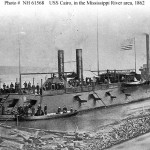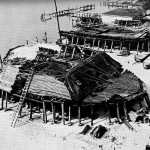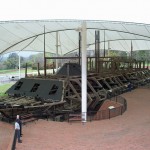 “…I heard an explosion from the Cairo, and on looking up (from a small boat on the river) I saw her anchor thrown up several feet in the air.” – Ensign Walter E.H. Fentress
“…I heard an explosion from the Cairo, and on looking up (from a small boat on the river) I saw her anchor thrown up several feet in the air.” – Ensign Walter E.H. Fentress
“…just as we were training on the battery (gun emplacement or torpedo), we were struck by a torpedo, which exploded under our starboard bow, a few feet from the center and some 35 or 40 feet from the bow proper just under our provision store room, which crushed in the bottom of the boat so that the water rushed in like the roar of Niagara. In five minutes the Hold was full of water and the forward part of the gunboat was flooded… One of our heaviest bow guns had been dismounted by the force of the explosion, injuring three men. ” -George Yost.
On December 12th, 1862, the American Civil War saw yet another military first: USS Cairo became the first warship sunk by an underwater mine, or torpedo as they were known at the time. The Union Navy had known of the Confederate devices since the summer of 1861 and had captured and destroyed dozens of them — and the weapons had been tried in past wars, such as the American Revolution and the by the Chinese and Russians — but this was the first time one had succeeded in sinking something other than a target hulk.
USS Cairo (pronounced KAY-ROW), one of the class of armored gunboats of the City Class, had served well before her date with fame on 12/12/62. She’d participated in most of the campaigns on the western rivers up to that point, as the Navy and Army for the first time in U.S. history worked in close coordination to ring up victory after victory in the west, but it was her sinking and eventual fate that would make her one of the most well-know 19th century warships.
Cairo sank fast, most estimates put the time from initial explosion (she actually hit two of the torpedoes) to being fully settled on the bottom in just twelve minutes. Only her chimneys (smoke stacks) and flag poles remained above water. More impressive than the quickness with which she sank was the fact that not a member of her crew was lost during the event.
Opinions vary as to whether the torpedoes that sank Cairo were of the common cask variety (old lager beer barrels filled  with gunpowder and contact-triggers) or the more complicated battery activated design (triggered by observers on shore by battery current through wires that ran to the torpedo to detonate it). Regardless, they did their job well, and others would continue to do so. More Union ships were lost to torpedoes than Confederate warships, fortifications, and gun batteries, combined.
with gunpowder and contact-triggers) or the more complicated battery activated design (triggered by observers on shore by battery current through wires that ran to the torpedo to detonate it). Regardless, they did their job well, and others would continue to do so. More Union ships were lost to torpedoes than Confederate warships, fortifications, and gun batteries, combined.
Sinking a warship was not necessarily a permanent result, as resurrecting warships on rivers during the Civil War was a common occurrence. Cairo’s sister, USS Cincinnati had been rammed and sunk earlier in 1862 and raised to fight again, and would be sunk and raised yet again in 1863. Cairo, however, had gone down in a narrow stretch of the Yazoo River, in enemy territory, and recovery was deemed too risky. One of Cairo’s consorts, Queen of the West, attached ropes to her stacks and flag poles and pulled them down, so that the Confederates would not know where she had sunk, and the expedition returned to the Mississippi River.
Cairo’s sisters fought out the rest of the war (except for Baron De Kalb**; she fell prey to a torpedo as well in July 1863 and was also left where she sank), and were subsequently sold off and scrapped. Cairo, however, laid where she had sank. It was reported by locals during the early 20th century that, during times of drought when the river ran low, you could see parts of the warship’s armored conning tower protruding above the slack river’s surface.
 USS Cairo’s wreck was positively located and identified in 1956, and raised in 1965. The book “Hardluck Ironclad” by historian Edwin C. Bearss details the operation, and is a step by step description of how one should NOT raise a sunken wreck. Large sections of the ship were lost when she broke apart on raising, and then the parts that were saved were left in the open air on a dock for months, causing most of them to simply rot and rust away (wood and iron that’s been on the bottom for a century needs to be specially treated, dried, etc.). Much of Cairo was salvaged, though, including hundreds of personal possessions from her crew, and she’s now a museum in Vicksburg, Mississippi, not far from where she sank. She is now one of the few Civil War warships that can still be seen today; unknowingly preserved for future generations by a new weapon of war, 150 years ago today.
USS Cairo’s wreck was positively located and identified in 1956, and raised in 1965. The book “Hardluck Ironclad” by historian Edwin C. Bearss details the operation, and is a step by step description of how one should NOT raise a sunken wreck. Large sections of the ship were lost when she broke apart on raising, and then the parts that were saved were left in the open air on a dock for months, causing most of them to simply rot and rust away (wood and iron that’s been on the bottom for a century needs to be specially treated, dried, etc.). Much of Cairo was salvaged, though, including hundreds of personal possessions from her crew, and she’s now a museum in Vicksburg, Mississippi, not far from where she sank. She is now one of the few Civil War warships that can still be seen today; unknowingly preserved for future generations by a new weapon of war, 150 years ago today.
**Trivia: You can see a wartime photo of Baron De Kalb (also known as St. Louis) for a split-second during the opening sequence and theme song of the television show “Big Bang Theory”